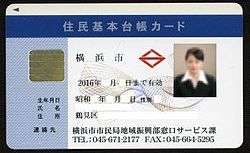Photo identification

Photo identification or photo ID is an identity document that includes a photograph of the holder, usually only his or her face. The most commonly accepted forms of photo ID are those issued by government authorities, such as driver's licenses, identity cards and passports, but special-purpose photo IDs may be also produced, such as internal security or access control cards.
Photo identification may be used for face-to-face authentication of identity of a party who either is personally unknown to the person in authority or because that person does not have access to a file, a directory, a registry or an information service that contains or that can render a photograph of somebody on account of that person's name and other personal information.
Types
Some countries – including almost all developed nations with the notable exceptions of the UK and the United States – use a single, government-issued type of card as a proof of age or citizenship.
The United States, United Kingdom, Australia, New Zealand, and Ireland do not have such a single type of card. Types of photo ID cards used in the US include:
- Passports[2]
- Driver's licenses, or state ID cards for non-drivers, issued by a state's Department of Motor Vehicles
- Railcard
- Company-issued ID cards
- Native tribal cards
History
Photo identification cards appear to have been first used at the 1876 Centennial Exposition in Philadelphia, Pennsylvania. The Scottish-born Canadian photographer William Notman, through his affiliated business, Centennial Photographic Co., which had exclusive photographic concession at the exhibition, introduced a photo identification system that was required for all exhibitors and employees of the exhibition. The innovation was known as a "photographic ticket".[3]
See also
References
- ↑ "Basic Resident Registration Card". Ministry of Internal Affairs and Communications. Retrieved 10 Dec 2014.
- ↑ Passport Photo Composition Template
- ↑ Hall, Roger, Gordon Dodds, Stanley Triggs (1993). The World of William Notman. David R. Godine. p. 46, 47. Retrieved 31 December 2015.